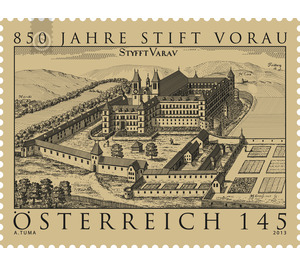850 years - Austria / II. Republic of Austria 2013 - 145 Euro Cent
Theme: History & Politics
| Country | Austria / II. Republic of Austria |
| Issue Date | 2013 |
| Face Value | 145.00 |
| Edition Issued | 270,000 |
| Printing Type | combination printing |
| Stamp Type | Commemorative |
| Item Type | Stamp |
| Chronological Issue Number | 2420 |
| Chronological Chapter | OOS-OE2 |
| SID | 419337 |
| In 60 Wishlists | |
Continuation of the popular series "Churches in Austria" - the new value is the theme of the imposing Augustinian monastery Vorau, which celebrates its 850th anniversary this year. The attractive brand motif shows the monastery complex in a colored engraving from the collegiate archives by G. M. Vischer (circa 1681). History: The monastery located in northeastern Styria was founded in 1163 by a certain margrave Ottokar III. founded by Traungau. After an extremely changeable centuries with numerous ups and downs the monastery reached its highest membership in its history in 1736 with 46 canons. In 1778, a secondary school was established, later led to 1843, including a private high school with a boys' choir institute. In 1844, the fortress walls were demolished and the moat was filled, causing the monastery to lose its castle character. After the so-called "Anschluss" in 1938, the pen initially experienced no reprisals, in the fall of the same year, the approach of the Nazi regime but massively changed: The pin was renamed after confiscation on April 19, 1940 in "Castle Vorau" and the Canons had to leave the monastery, which was now administered under Nazi rule, immediately. Apart from three monks, who were allowed to stay in the village, everyone was referred to district and Gau and had to look for a new accommodation. On 4 October 1940, the entire property of the monastery was confiscated in favor of the German Reich. This was the first time since its founding that the abbey was abolished - unable to defend itself against the harassment of the Third Reich. As a reason for the abolition and the establishment of a national political educational institution ("Napola") were called attacks on girls and boys by the canons. The fact that already in May 1940 a Vorommando came from the Theresianum in Vienna to Vorau, shows how eager it was the responsible party members to set up a Napola in the former pen. After the end of the war, on May 27, 1945, the monks from the congregation of the Austrian Augustinian Canons returned to the heavily damaged abbey and began the arduous reconstruction, which could only be completed at the end of the sixties. From 1981 to 1987, all the convent buildings were renovated, from 1995 to 1997, finally, an extension to the administration building. Special mention deserves - in addition to the extremely valuable library - of course also opened in 1977 pen own education house, in which under the guidance of the dedicated provost Gerhard Rechberger interesting religious events and seminars lasting several days are offered.


